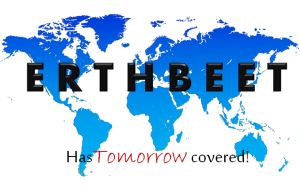Encosion – the Erthbeet Time Protocol
Most of the general public won’t be interested in Encosion or how it contributes to a viable solution for universal world time, but this detail is provided for those that may be. This information is for technical interest, and is not at all needed to be understood to use Erthbeet Time practically. This information is only to describe the logical background machinery that generates the Erthbeet Time protocol. This protocol may also be referred to as either the Universal World Time Protocol (UWTP) or the Erthbeet Time Protocol (EBT).
The terminology will depend on the future of the protocol, & whether it may be accepted by ISO, or whether it will require changes or re-development. Erthbeet also has significant additions to add to the Erthbeet Time Protocol, so at this stage, the EBT protocol remains ours as a concept, but will probably eventually become open for multi-government input, for which it would be referred to as UWTP. And we would fully support this provided that we are consulted. As well as being the original creator, we have already invested in developing this protocol, & the changes & additions we have developed are significant for tomorrow’s internet, as well as for use by anticipated technologies yet to arrive, including our own.
Encosion is the process name for building tokenized time
The Erthbeet Time protocol (EBT) is a time protocol specification which in itself encompasses several other specifications, one of which is called encosion. Encosion is a process name, & the underlying formula that drives encosion is called: quadrant denotional base-26. The encosion process, while not overly complex, requires a sound mathematical grasp. Erthbeet has created its own terminology for these aspects of the EBT protocol which has helped to make these concepts easier to discuss during the development & beta phases. The fundamental reference point of time for Erthbeet Time is the chronox. The chronox is the first day of Erthbeet time & is the reference point by which all Erthbeet Time calculations are made.

Encosion is the engine that builds the Erthbeet time protocol which ultimately creates a single global time zone
Encosion is the process that converts standard time into Erthbeet time, and vise versa. The quadrant denotional base-26 formula is used to enable shorter notation of time & to extend the lifetime of the base-26 MSD place-number. So the encosion process does two things: it encodes & decodes between standard time & Erthbeet time, & it also compresses Erthbeet Time notation using the quadrant denotional base-26 formula.
Both encosion & quadrant denotional base-26 are time encoding & compression algorithms, developed by Erthbeet Pty Ltd & are designed to provide a durable solution for expressing a full date-time in a small package, long into the future. Both work together as part of the process of building the Erthbeet Time protocol.
UTC & Erthbeet Time Encosion
Erthbeet Time follows standard time for its incrementation, & uses UTC (Coordinated Universal Time) for its fundamental time reference point. However, the Erthbeet week is only four days, with one 96-hour clock, & is seen by erthbeet as four unique 24-hour clocks. The hour portion of the four digits of an Erthbeet time (ie 13 of ac1345) is used denotionally. This means that the hour value is given dual purpose. While the hour value must express the hour time value, it also denotes one of four days of the erthbeet week.
If day1 of the erthbeet week, then the clock’s hours will be in the range 0-23.
If day2 of the erthbeet week, then the clocks’ hours will be in the range 24-47.
If day3 of the erthbeet week, then the clock’s hours will be in the range 48-71.
If day4 of the erthbeet week, then the clocks’ hours will be in the range 72-95.

The Erthbeet clock uses encosion to operate using four unique 24-hour clocks. This process is necessary but transparent to the general public.
Fig. 1 Each clock is a different 24-hour clock, each representing one 24 hour day.
So we have four days, consisting of four different clocks, making it a quadranted time system. And the purpose of the four different clocks is to denote the day value of the erthbeet week. That is why the formula is officially called quadrant denotional base-26. The purpose of using denotional hours in Erthbeet Time is to be able to flag when the end of the Erthbeet week occurs. What does the end of an erthbeet 4-day week mean? It means that the alpha base-26 number (ac in the example) of an Erthbeet time, & which is the time difference in days between the chronox & the relevant erthbeet date, advances by one.
Encosion was developed after the third Erthbeet time development version, with the purpose of compressing Erthbeet time notation. During development of Erthbeet Time version 2.0, it was soon realized that a base-26 system alone was not going to be efficient enough. Efficiency, regarding Erthbeet time, involves:
- Expression of date+time notation being as short as possible.
- The encoded time notation being easy for people to handle & remember.
- The time notation to be free of any possibility of confusion or ambiguity.
- The time data to be as little in bytes as possible for database handling & storage.
- The time formula requiring as little processor resource as possible.
- The time standard & notation being useable & acceptable for most countries & cultures.
Getting the best of all these requirements was important not only from a technical perspective, but surprisingly from a cultural & social perspective. For example, a base-52 system was considered & could have been used to maximize time span notational efficiency, but this would have weakened one of the other primary directives mentioned above. From a product perspective, the EBT protocol can never be changed or revised, so the mission was always to ‘get it right’ first time around to accommodate not only our century, but people in the next.
Encosion allows Erthbeet Time to be proposed as a robust universal world time solution. Without encosion Erthbeet Time would still be a workable solution, but a weak proposition. After much conceptual time & experiment, & for factors not mentioned, we believe that this system represents the best possible proposal for a universal world time solution, and one that will gain universal acceptance in time.

Erthbeet offers a brilliant solution for a safe 25th time zone which is a global time zone, using the encosion process
So, why have we implemented encosion? In the form of a Universal Time Link (UTL), encosion doesn’t really help, but in the event that Erthbeet time becomes popular, there will also be the need for manual handling of an Erthbeet time code as well as remembering an Erthbeet time, which would be difficult without Encosion. But the main reason is for processes behind the scenes, when an Erthbeet server becomes extremely busy with time zone conversion calculations, where encosion will greatly speed up the task of millions of calculations per minute. Encosion enables an unambiguous expression of a moment within a very light-weight protocol, which will become important one day when the internet is carrying 100 million time requests per minute.
















